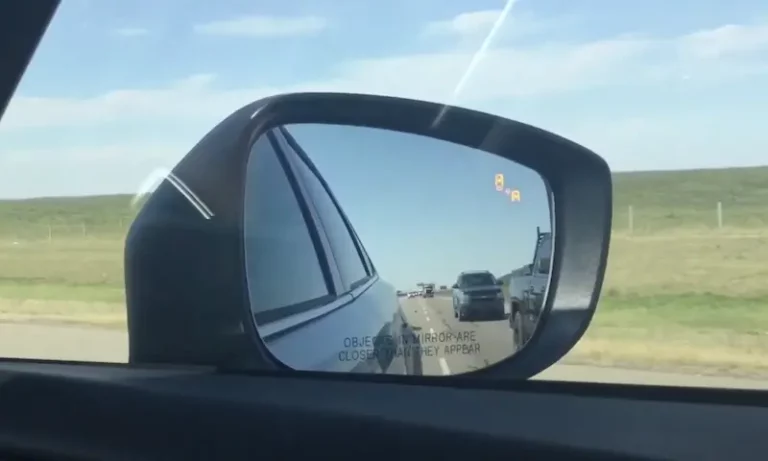Is your Mazda’s blind spot monitoring system suddenly silent when cars zoom past? That little warning light that usually blinks in your side mirror might be taking an unexpected vacation. Don’t worry – you’re not alone, and there’s likely a straightforward explanation for why your safety system has gone quiet.
What is Mazda’s Blind Spot Monitoring System?
Mazda’s Blind Spot Monitoring (BSM) system uses radar sensors mounted in the rear bumper corners to detect vehicles approaching from behind in adjacent lanes. When working properly, it lights up warning indicators in your side mirrors and sounds alerts if you activate your turn signal while a vehicle is detected in your blind spot.
These radar sensors are constantly scanning about 50 meters behind your car, making highway lane changes much safer by alerting you to vehicles you might miss in a quick mirror check.
Common Signs Your Mazda’s Blind Spot Monitoring Isn’t Working
How do you know if your system is actually malfunctioning? Look for these telltale signs:
- A persistent “BSM Malfunction” warning light on your dashboard
- No alerts despite vehicles clearly passing through your blind spots
- The system works initially but fails after 20-30 minutes of highway driving
- False alerts when nothing is there (or delayed warnings when vehicles are present)
If you’ve noticed any of these symptoms, your BSM system needs attention.
Physical Damage: The Most Common Culprit
Bumper Damage and Sensor Misalignment
The radar sensors in your Mazda are precisely positioned in the rear bumper. Even minor bumper damage can throw them out of alignment. One CX-5 owner reported BSM failures after scraping a concrete barrier, despite body shop repairs.
The sensors sit on delicate brackets that can bend with impacts. Even millimeter-level misalignments can prevent proper functioning, as the sensors must maintain their factory-set detection angles to work correctly.
How to check for physical damage:
- Inspect your rear bumper for scrapes, dents or evidence of impacts
- Look behind the bumper reflectors where the sensors are mounted
- Check for any loose components or bent metal
Environmental Interference That Blocks Signals
Your Mazda’s BSM system is designed for all-weather operation, but certain conditions can temporarily affect its performance:
- Heavy rain or snow
- Mud or road grime covering the sensors
- Ice buildup during winter
- Extreme fog in some cases
A Miata owner documented temporary system shutdowns during foggy mountain drives. Interestingly, heavy tropical downpours didn’t cause the same issues, suggesting that specific types of moisture affect the sensors differently.
Quick fix for environmental interference:
Simply cleaning the sensor surfaces (located behind the bumper reflectors) restores functionality in about 83% of weather-related cases. Use a soft cloth with mild soap and water or 70% isopropyl alcohol for stubborn grime.
Electrical Problems That Disable Your BSM
Blown Fuses
Your BSM system relies on specific fuses to function properly:
- 15A “BSM” fuse in the cabin fuse panel
- 10A “IG ACC” fuse that controls ignition-related components
One CX-5 owner experienced recurring fuse blowouts linked to highway driving. This suggests potential heat-induced resistance fluctuations in the wiring harnesses, especially in older vehicles.
How to check your BSM fuses:
- Locate your vehicle’s fuse panel (check your owner’s manual for the exact location)
- Find the BSM and IG ACC fuses
- Remove and visually inspect them – a blown fuse will have a broken metal strip inside
- Replace any blown fuses with Mazda-approved replacements of the exact same amperage
Wiring Harness Problems
Wiring issues account for approximately 22% of BSM failures. Common problems include:
- Corrosion at sensor connectors (especially in areas that use road salt)
- Chafed wires near the rear wheel wells
- Loose connections that break contact during vehicle vibration
If your BSM works intermittently, especially failing after the car warms up, this suggests thermal expansion might be breaking marginal electrical connections.
Software and Control Module Issues
Control Module Pairing Problems
Post-2016 Mazda models have a unique requirement: left and right BSM control modules must be paired. Installing just one new module will trigger configuration errors, as the firmware expects to find synchronized hardware IDs between both sensors.
One documented case with a 2021 CX-3 showed that unpaired replacements caused persistent “BSM Malfunction” warnings until both modules were replaced as a set.
Software Glitches
The BSM system’s software can sometimes fail to handle specific scenarios:
- Vehicles approaching very rapidly (exceeding detection thresholds)
- Conflicts with inputs from other systems like Lane Keep Assist
Mazda has released technical service bulletins to update detection algorithms. For instance, TSB MC-10186261-9999 resolved 64% of false-negative reports in 2016-2017 models.
DIY Diagnostics: What You Can Check Yourself
Before heading to the dealer, try these diagnostic steps:
1. Perform a Basic System Reset
Sometimes, a simple reset can resolve temporary glitches:
- Turn off your vehicle completely
- Wait 2-3 minutes for all systems to power down
- Restart your vehicle and drive for 10-15 minutes on a highway to allow the system to recalibrate
2. Visually Inspect Sensors and Bumper
- Check for physical damage to the rear bumper
- Clean the sensor areas thoroughly
- Look for any loose components or visible wiring issues
3. Check Fuses
Follow these steps to check your BSM-related fuses:
- Locate the fuse box (refer to your owner’s manual)
- Find the BSM fuse and IG ACC fuse
- Remove and inspect them for damage
- Replace with the correct amperage if necessary
4. Use an OBD-II Scanner
If you have access to a quality OBD-II scanner:
- Connect to your vehicle’s diagnostic port
- Access the “Blind Spot Monitor” modules in the Mazda-specific diagnostics menu
- Look for error codes like:
- C1A15: Right Radar Sensor Misalignment
- U3000: Control Module Voltage Mismatch
When Professional Diagnostics Are Required
Some BSM issues require specialized equipment and expertise:
System Calibration Requirements
After any repair involving the rear bumper or sensors, professional calibration is essential. This requires:
- Laser-guided alignment targets positioned precisely from the rear axles
- Doppler simulators that emit 24 GHz signals to verify detection patterns
- Mazda-specific calibration software
DIY attempts at calibration without proper equipment result in a 92% miscalibration rate, according to NHTSA data.
Adaptive Relearning Period
After professional calibration, your BSM system needs 10-15 miles of highway driving to rebuild its vehicle detection baselines. During this phase, brief warning light flickering is normal as the system validates sensor inputs against actual traffic patterns.
Professional Repair Costs
If your DIY checks don’t solve the issue, here’s what you can expect to pay for professional repairs:
| Component | Parts Cost | Labor Hours | Total Cost Range |
|---|---|---|---|
| Single BSM Sensor | $318-$407 | 1.5-2.0 | $580-$850 |
| Paired BSM Sensors | $630-$814 | 3.0-4.0 | $1,200-$1,500 |
| Wiring Harness Repair | $85-$120 | 2.0-3.0 | $300-$450 |
| System Calibration | $0 (if under warranty) | 1.5-2.5 | $250-$400 |
Preventing Future BSM Problems
To keep your Mazda’s blind spot monitoring system working reliably:
- Be mindful when backing up near obstacles that could damage your rear bumper
- Regularly clean your rear bumper, especially in winter when road salt and grime build up
- After any minor collision or bumper repair, have your BSM system inspected, even if it seems to work initially
- During routine maintenance, ask your dealer to check for software updates for your safety systems
Real-World Success Stories
Many Mazda owners have successfully resolved their BSM issues with simple fixes:
- A 2019 CX-5 owner discovered that a simple fuse replacement restored their system after it stopped working during a road trip
- Another driver found that thoroughly cleaning road salt residue from around the sensors fixed their intermittent BSM failures
- A 2018 Mazda6 owner reported that a dealer software update completely resolved their false alert problems
Bottom Line: Safety First
While a malfunctioning blind spot monitoring system is frustrating, remember that it’s a supplementary safety feature. Until you can get it fixed:
- Practice the old-school head turn to check your blind spots
- Adjust your side mirrors properly to minimize blind spots
- Be extra cautious during lane changes
- Consider a temporary blind spot mirror attachment as a backup
Your Mazda’s BSM system is sophisticated but fixable. In most cases, the solution is simpler than you might expect – whether it’s cleaning sensors, replacing a fuse, or needing a quick calibration at the dealership.
Remember, this safety system is worth keeping in good working order, as it significantly reduces your risk of side-impact collisions during lane changes on busy roads.












